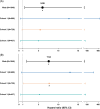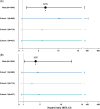Genome-wide meta-analysis associates donor-recipient non-HLA genetic mismatch with acute cellular rejection post-liver transplantation
- PMID: 39670865
- PMCID: PMC11637756
- DOI: 10.1097/HC9.0000000000000601
Genome-wide meta-analysis associates donor-recipient non-HLA genetic mismatch with acute cellular rejection post-liver transplantation
Abstract
Background: Acute cellular rejection (ACR) remains a common complication causing significant morbidity post-liver transplantation. Non-human leukocyte antigen (non-HLA) mismatches were associated with an increased risk of ACR in kidney transplantation. Therefore, we hypothesized that donor-recipient non-HLA genetic mismatch is associated with increased ACR incidence post-liver transplantation.
Methods: We conducted an international multicenter case-control genome-wide association study of donor-recipient liver transplant pairs in 3 independent cohorts, totaling 1846 pairs. To assess genetic mismatch burden, we calculated sum scores for single-nucleotide polymorphism (SNP) mismatch based on all non-HLA functional SNPs, specifically SNPs coding for transmembrane or secreted proteins as they more likely affect the immune system. We analyzed the association between the non-HLA mismatch scores and ACR in a multivariable Cox regression model per cohort, followed by a weighted meta-analysis.
Results: During the first year post-transplantation, 90 of 689 (13%), 161 of 720 (22%), and 48 of 437 (11%) recipients experienced ACR in cohorts 1-3, respectively. Weighted meta-analyses showed that higher mismatch in functional non-HLA SNPs was associated with an increased incidence of ACR (HR 5.99; 95% CI: 1.39-20.08; p=0.011). Moreover, we found a larger effect of mismatch in SNPs coding for transmembrane or secreted proteins on ACR (HR 7.54; 95% CI 1.95-28.79; p=0.003). Sensitivity analyses showed that imputed HLA mismatch did not affect the associations between both non-HLA mismatch scores and ACR.
Conclusions: Donor-recipient mismatch of functional non-HLA SNPs overall and, especially, of SNPs encoding transmembrane or secreted proteins correlated with 1-year ACR post-liver transplantation. Identifying high-risk immunological burdens between pairs may prevent early graft rejection and aid in personalizing immunosuppressive therapy. Future studies are, however, needed to validate our findings using a genotyped HLA cohort.
Copyright © 2024 The Author(s). Published by Wolters Kluwer Health, Inc. on behalf of the American Association for the Study of Liver Diseases.
Conflict of interest statement
Vincent E. de Meijer reports a VENI research grant by the Dutch Research Council (NWO; grant #09150161810030), a Research grant from the Dutch Ministry of Economic Affairs (Health~Holland Public Private Partnership grant #PPP-2019-024), and a Research grant from the Dutch Society for Gastroenterology (NVGE #01-2021), all outside the submitted work. Eleonora A. M. Festen is supported by a Clinical Fellow grant from the Dutch Research Council (NWO; grant #90719075) and a Research grant from the Dutch Ministry of Economics. Hans Blokzijl received grants from Abbvie. Henkjan Verkade is on the speaker’s bureau, and received grants from Albireo/ Ipsen. He consults and received grants from Mirum. He consults for Orphalan and Vertex. He is on the speaker’s bureau for Astellas. Rinse Weersma consults and received grants from Takeda Pharmaceuticals. He is on the speaker’s bureau for Abbvie and Ferring. He received grants from Johnson and Johnson. Eleonora Festen received grants from Takeda. The remaining authors have no conflicts to report.
Figures





References
-
- Burra P. The adolescent and liver transplantation. J Hepatol. 2012;56:714–722. - PubMed
-
- Wiesner RH, Demetris JA, Belle SH, Seaberg EC, Lake JR, Zetterman RK, et al. . Acute hepatic allograft rejection: Incidence, risk factors, and impact on outcome. Hepatology. 1998;28:638–645. - PubMed
-
- Choi D, Liu M, Guttikonda D, Galen K, Guzman G, Jeon H, et al. . Recipient risk factors for acute cellular rejection after orthotopic liver transplant - a single-center, retrospective study. Transpl Int. 2020;33:1779–1787. - PubMed
-
- Reindl-Schwaighofer R, Heinzel A, Kainz A, van Setten J, Jelencsics K, Hu K, et al. . Contribution of non-HLA incompatibility between donor and recipient to kidney allograft survival: Genome-wide analysis in a prospective cohort. Lancet. 2019;393:910–917. - PubMed
Publication types
MeSH terms
LinkOut - more resources
Full Text Sources
Medical
Research Materials

